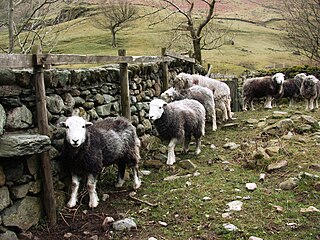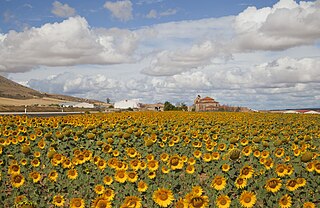
Hay is grass, legumes, or other herbaceous plants that have been cut and dried to be stored for use as animal fodder, either for large grazing animals raised as livestock, such as cattle, horses, goats, and sheep, or for smaller domesticated animals such as rabbits and guinea pigs. Pigs can eat hay, but do not digest it as efficiently as herbivores do.
The following outline is provided as an overview of and topical guide to agriculture:

Organic farming, also known as ecological farming or biological farming, is an agricultural system that uses fertilizers of organic origin such as compost manure, green manure, and bone meal and places emphasis on techniques such as crop rotation and companion planting. It originated early in the 20th century in reaction to rapidly changing farming practices. Certified organic agriculture accounts for 70 million hectares globally, with over half of that total in Australia. Organic farming continues to be developed by various organizations today. Biological pest control, mixed cropping, and the fostering of insect predators are encouraged. Organic standards are designed to allow the use of naturally-occurring substances while prohibiting or strictly limiting synthetic substances. For instance, naturally-occurring pesticides such as pyrethrin are permitted, while synthetic fertilizers and pesticides are generally prohibited. Synthetic substances that are allowed include, for example, copper sulfate, elemental sulfur, and ivermectin. Genetically modified organisms, nanomaterials, human sewage sludge, plant growth regulators, hormones, and antibiotic use in livestock husbandry are prohibited. Organic farming advocates claim advantages in sustainability, openness, self-sufficiency, autonomy and independence, health, food security, and food safety.

Precision agriculture (PA) is a farming management strategy based on observing, measuring and responding to temporal and spatial variability to improve agricultural production sustainability. It is used in both crop and livestock production. Precision agriculture often employs technologies to automate agricultural operations, improving their diagnosis, decision-making or performing. First conceptual work on PA and practical applications go back in the late 1980s. The goal of precision agriculture research is to define a decision support system (DSS) for whole farm management with the goal of optimizing returns on inputs while preserving resources.

Intensive agriculture, also known as intensive farming, conventional, or industrial agriculture, is a type of agriculture, both of crop plants and of animals, with higher levels of input and output per unit of agricultural land area. It is characterized by a low fallow ratio, higher use of inputs such as capital and labour, and higher crop yields per unit land area.

Pasture is land used for grazing.

In agriculture, rotational grazing, as opposed to continuous grazing, describes many systems of pasturing, whereby livestock are moved to portions of the pasture, called paddocks, while the other portions rest. Each paddock must provide all the needs of the livestock, such as food, water and sometimes shade and shelter. The approach often produces lower outputs than more intensive animal farming operations, but requires lower inputs, and therefore sometimes produces higher net farm income per animal.

A feedlot or feed yard is a type of animal feeding operation (AFO) which is used in intensive animal farming, notably beef cattle, but also swine, horses, sheep, turkeys, chickens or ducks, prior to slaughter. Large beef feedlots are called concentrated animal feeding operations (CAFO) in the United States and intensive livestock operations (ILOs) or confined feeding operations (CFO) in Canada. They may contain thousands of animals in an array of pens.

Extensive farming or extensive agriculture is an agricultural production system that uses small inputs of labour, fertilizers, and capital, relative to the land area being farmed.
In agriculture, the yield is a measurement of the amount of a crop grown, or product such as wool, meat or milk produced, per unit area of land. The seed ratio is another way of calculating yields.

Pastoral farming is aimed at producing livestock, rather than growing crops. Examples include dairy farming, raising beef cattle, and raising sheep for wool. In contrast, arable farming concentrates on crops rather than livestock. Finally, mixed farming incorporates livestock and crops on a single farm. Some mixed farmers grow crops purely as fodder for their livestock; some crop farmers grow fodder and sell it. In some cases pastoral farmers are known as graziers, and in some cases pastoralists. Pastoral farming is a non-nomadic form of pastoralism in which the livestock farmer has some form of ownership of the land used, giving the farmer more economic incentive to improve the land. Unlike other pastoral systems, pastoral farmers are sedentary and do not change locations in search of fresh resources. Rather, pastoral farmers adjust their pastures to fit the needs of their animals. Improvements include drainage, stock tanks, irrigation and sowing clover.

In agriculture, a field is an area of land, enclosed or otherwise, used for agricultural purposes such as cultivating crops or as a paddock or other enclosure for livestock. A field may also be an area left to lie fallow or as arable land.

Themeda triandra is a species of C4 perennial tussock-forming grass widespread in Africa, Australia, Asia and the Pacific. In Australia it is commonly known as kangaroo grass and in East Africa and South Africa it is known as red grass and red oat grass or as rooigras in Afrikaans. Kangaroo grass was formerly thought to be one of two species, and was named Themeda australis.

Industrial agriculture is a form of modern farming that refers to the industrialized production of crops and animals and animal products like eggs or milk. The methods of industrial agriculture include innovation in agricultural machinery and farming methods, genetic technology, techniques for achieving economies of scale in production, the creation of new markets for consumption, the application of patent protection to genetic information, and global trade. These methods are widespread in developed nations and increasingly prevalent worldwide. Most of the meat, dairy, eggs, fruits and vegetables available in supermarkets are produced in this way.

Intensive crop farming is a modern industrialized form of crop farming. Intensive crop farming's methods include innovation in agricultural machinery, farming methods, genetic engineering technology, techniques for achieving economies of scale in production, the creation of new markets for consumption, patent protection of genetic information, and global trade. These methods are widespread in developed nations.

Chloris gayana is a species of grass known by the common name Rhodes grass. It is native to Africa but it can be found throughout the tropical and subtropical world as a naturalized species.
Convertible husbandry, also known as alternate husbandry or up-and-down husbandry, is a method of farming whereby strips of arable farmland were temporarily converted into grass pasture, known as leys. These remained under grass for up to 10 years before being ploughed under again, while some eventually became permanent pasturage. It was a process used during the 16th century through the 19th century by "which a higher proportion of land was used to support increasing numbers of livestock in many parts of England." Its adoption was an important component of the British Agricultural Revolution.

Chamaecrista rotundifolia, round-leaf cassia, also known as pasto rastiero, roundleaf sensitive pea, and Wynn cassia, is a short-lived perennial or self-generating annual plant in the subfamily Caesalpinioideae of the family Fabaceae. It originated in North America, Mesoamerica, the Caribbean, and Tropical South America but is grown in other parts of the world today. It grows in dry soils and areas of low rainfall, as well as in low-fertility and acidic soils with high levels of solubilized aluminum. It can also reduce erosion and runoff over time. These factors make it a potential asset to farmers in the African Subtropics and elsewhere where soil quality is a barrier to farming. It serves as a source of feed for livestock and acts as a green fertilizer, raising soil quality and nutrient content which can improve yields. These combined benefits make round-leaf cassia a potential solution to many problems faced by poor farmers and their communities.

Dr Meredith Leigh Mitchell an Australian agronomist. She is a senior research scientist with the Victorian Department of Environment and Primary Industries.
This glossary of agriculture is a list of definitions of terms and concepts used in agriculture, its sub-disciplines, and related fields. For other glossaries relevant to agricultural science, see Glossary of biology, Glossary of ecology, Glossary of environmental science, and Glossary of botanical terms.














